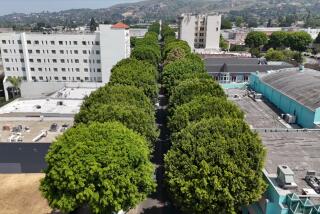A Tree Grows in Controversy
Oh Christmas tree, oh Christmas tree,
How lovely are your branches!
Oh Christmas tree, oh Christmas tree,
How lovely are your branches!
--Traditional German song Well, the branches were lovely, 10 days ago when you brought the tree home from the “fresh-cut/live-tree” lot, strung it with lights, loaded it with ornaments and placed gifts all around.
But now the gifts are gone, the branches are drooping and, despite the water in the Christmas tree’s holder, its needles are as brittle as straw. In living rooms all across the country today, Scotch pines, blue spruces and Douglas firs by the millions are drying up and shedding their needles, unable to muster the stamina needed to see them through New Year’s Day.
Look again, though.
While an estimated 35 million decorated “live” trees wither into rigor mortis, another 35 million or so living-room adornments remain as rich and green as the day they came off the assembly line in polyvinyl chloride splendor, complete with a lifetime guarantee. The artificial tree, although long scorned by purists, continues to grow in popularity, thanks in part to upgraded appearance and a big boost from an unlikely quarter--the reinvigorated environmental movement.
These plastic trees, ironically, could be considered the true evergreens, and they might be seen as the tree of the future, says a Canadian horticulturist who has studied the phenomenon of the “pseudo plant.”
Roger Vick, curator of the Devonian Botanic Garden at the University of Alberta in Edmonton, suggests that the growing acceptance of artificial Christmas trees might signal a trend toward year-round use of artificial landscapes both inside and out.
Writing earlier this year for The Futurist magazine, Vick noted that, not long ago, the artificial plastic or paper plant was instantly recognized for the fake it was and commonly rejected. In contrast, today’s silk-screened polyester plants look real enough to pick. Already, says Vick, they are being used in shopping malls, hospitals and office complexes, because they don’t demand soil, water, weeding, pruning, pesticides, humidity or sunlight.
“Another indication of this trend,” he writes, “is evident with the increasing popularity of the artificial Christmas tree.” Not only is it expensive to buy a new tree every year, he says, it flies in the face of today’s growing awareness of environmental stewardship. “The tree that is cut down to serve as a temporary decoration--and promptly added to the garbage problem--will be increasingly perceived as one more extravagance of man against nature and hardly in keeping with the spirit of the season,” he writes.
Furthermore, he says, if both artificial Christmas trees and artificial indoor plants are now being generally accepted, the “logical progression is the acceptance of un-plants into the outdoor courtyard and garden landscape.”
Interviewed by phone last week, Vick, who oversees 110 acres of lawns, lakes and gardens, including almost 4,000 plant varieties at the University of Alberta’s botanical gardens, emphasized that he is not advocating artificial plants.
“I don’t want to get labeled ‘pro-pseudo plant,’ ” he said. “I am just waving a warning flag.”
But on the subject of Christmas trees, he votes unequivocally for plastic. “I have three of them--we’re using a pine tree this year. Year after year, you can bring out your artificial tree. Then it all collapses neatly and folds into a box when Christmas is over.”
Vick’s ability to separate the Christmas tree from the rest of “artificial nature” is not universal among environmentalists. “I am appalled by the idea of outdoor fake stuff and I disagree with him,” declared landscape architect Regula Campbell of Santa Monica, when asked about the issue. She and her husband, Bill, run Campbell and Campbell, a firm that is “very environmentally concerned.”
The idea of 35 million polyvinyl chloride trees glowing with lights in American homes this season does not please her. “The Christmas tree is an ancient symbol, and it’s very much about nature and our connection with nature,” she said.
“I definitely would not buy an artificial tree. I suppose I am a traditionalist, but it doesn’t bother me that Christmas trees are chopped down. I look at them as a seasonal crop, like pumpkins at Thanksgiving.”
Campbell, however, did offer a compromise. “People can buy a living tree, which is a wonderful thing to do. I would buy an Italian Stone Pine or a Bishop Pine--they’re good for this area--and I would give it to the Parks Department after Christmas. It’s appropriateness we are talking about, and artificial trees are not appropriate.”
More to Read
Sign up for Essential California
The most important California stories and recommendations in your inbox every morning.
You may occasionally receive promotional content from the Los Angeles Times.










